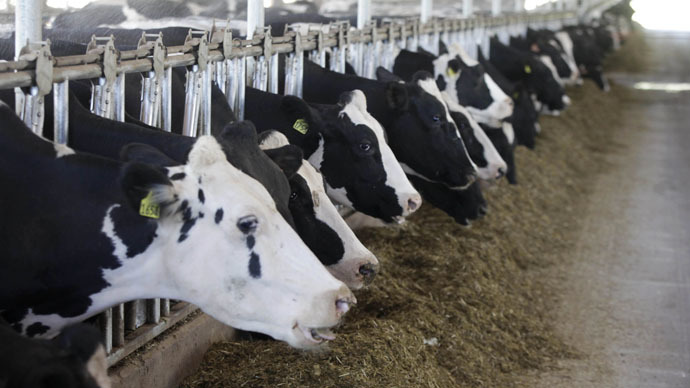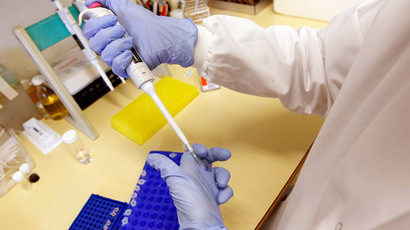Use of antibiotics in cattle feed leads to airborne antibiotic-resistant bacteria – study

DNA from antibiotic-resistant bacteria is spreading from cattle feedlots across the US through the air, a new study has found. The report indicates that so-called superbugs threatening humans could be traced to the use of antibiotics in cattle feed.
Antibiotic-resistant bacterial DNA is known to be transferable to humans if ingested via water or meat. The authors of the study sought to determine the extent to which antibiotics, antibiotic-resistance genes and microbes associated with ruminants like cattle are dispersed into the air via particulate matter derived from large scale beef cattle feedyards, they wrote in their abstract. The paper is set to be published in April.
Despite evidence that agricultural use of antibiotics is a contributor to antibiotic-resistance, animal agriculture uses nearly 10 million kg of antibiotics annually in the United States alone.
"This is the first test to open our eyes to the fact that we could be breathing these things," Phil Smith, one of the paper’s authors and an environmental toxicologist at Texas Tech University, told the Texas Tribune.
READ MORE: Superbugs could kill 10mn per year by 2050, more than cancer – study
The scientists looked at the more than three-quarters of all cattle on US feedyards with more than 1,000 head ‒ a total of 8.24 million cattle ‒ were located in Texas, Oklahoma, Kansas, Nebraska and Colorado, an area called the Southern High Plains that “has the highest frequency of dust storms in the United States and the highest density of feedyards,” the authors noted.
“Feedyard pen floor material, which consists primarily of urine and fecal material, becomes dry and brittle, thus becoming source material for fugitive dust” from the feedyards in the region, the researchers wrote. “Thus, in semi-arid regions where a majority of beef cattle feedyards exist in North America, transport of livestock-generated organic wastes occurs largely via wind.”
Between August and December 2012, the researchers collected particulate matter samples in air filters from areas next to ten commercial beef cattle feedyards in the Southern High Plains. They measured the air both upwind and downwind of the ten locations for half an hour in the afternoons “when cattle are most active and the greatest amount of [particulate matter] is produced.” They then extracted the DNA from the particulate matter bound to the air filters, in which they detected the presence of nine antibiotic resistant genes.
The scientists also measured whether there were differences between the upwind and downwind particulate matter, and they found that the downwind air contained antibiotics, bacteria, and a much greater number of microbial communities containing antibiotic-resistant genes than the upwind air.
They noted that three tetracycline antibiotics (tetracycline, chlortetracycline, and oxytetracycline) were detected together in the majority of particulate matter samples downwind of feedyards (60 percent), while oxytetracycline was the most frequently detected of the three antibiotics, and it was detected in 100 percent of the samples collected downwind of feedyards and 30 percent of upwind samples.
"The 'aha' moment came when we saw how much more prevalent resistant sequences were downwind than upwind," Greg Mayer, a molecular biologist at Texas Tech and one of the study’s authors, told the Texas Tribune. "It was not just higher in some of them – it was 4,000 percent more. It made me not want to breathe."
The authors noted their concern in their paper.
“This study clearly demonstrates the potential for antibiotics and bacteria to be transported from beef cattle feedyards into the environment by wind. Thus, it is reasonable to consider how far microbes may be transported from these sources, and if they remain viable after aerial transport,” the researchers wrote. “This study was not designed to address these questions directly, rather it was intended to quantify airborne antibiotics, changes in microbial community composition, and identify antibiotic resistance genes derived from a potential source.”
READ MORE: Antibiotics 'fail 15%' of patients due to superbugs and ‘reckless’ prescription
“While many of the veterinary antibiotics approved for use in beef cattle production are not intended for human use, the potential for resistance to multiple antibiotics within the same class or otherwise, including those intended for human use, has been documented,” they added.
The cattle industry is pushing back against the study, saying it misrepresents the risk of super bacteria to human health, and deems its findings partial and inconclusive. Dr. Sam Ives, a veterinarian working with the Texas Cattle Feeders Association, told the Texas Tribune that antibiotic use in the industry is "judicious."
"If I truly thought that the usage of these products was putting anyone at danger, I wouldn't be using them," Ives said. "My children work with me in the feedlot; my wife works with me. Am I concerned for their safety? No, I'm not."
But physicians may be taking the researchers’ side. In 10 years of treating patients at his Lubbock clinic, Dr. Randall Wolcott told the Texas Tribune that he has seen bacteria grow increasingly resistant to antibiotics used to treat their infections.
"We know that antibiotic-resistant genes are becoming more common," Wolcott said. "We use too many antibiotics for animal health, and it keeps food prices down. Is it a good tradeoff? This research is a piece of the puzzle that will help decide that question.”














